I just completed Arx Fatalis, the first game developed by Arkane Studios. Released in 2002, it is an Immersive Sim RPG designed as a spiritual successor to the first game developed by the illustrious Looking Glass Studios (then Blue Sky Productions), Ultima Underworld, which I played in 2018. My first exposure to Arkane Studios was with their 2012 title Dishonored which I rather liked at the time, and I’ve since played and replayed Prey (2017) and its 2018 Mooncrash expansion, culminating in my producing an extensive balance modification for the former with similar plans for the latter to come soon. It’s safe to say I’m a general fan of Arkane’s output, as well as the broader design lineage that’s inspired them over the years. I make note of all of this because Arx Fatalis is my favorite of Arkane’s work to date. I had heard good things about the title, and I have an established preference for the second wave of ImSims (Deus Ex, System Shock 2, Thief Gold), but nothing could have prepared me for how engrossed I became in the world of Arx and how much it consumed my thoughts over the last week. The game took me 40 hours to complete, which I managed to do in only 8 days owing to the itch I felt to play it from the moment I’d wake up to the moment I’d lay my head on my pillow. Here I’ll be detailing my experience with the game and going over what I think it does well and what I think could be improved – I still have many criticisms of the game despite my glowing praise.
The first thing to understand about Arx Fatalis is what it’s setting out to do. Taking after the first Immersive Sim, it’s a real-time first-person dungeon crawler RPG with the goal of allowing the player to interact with the world through simulated systems that afford them the freedom to solve problems using real-world logic. This is not to say it’s a purely open-ended sandbox game – there are still quests to complete and a story that plays out in a largely linear manner – but the moment-to-moment gameplay is driven by a ruleset that rewards creative thinking in applying one’s tools to approach any given obstacle. The game opens with the player character being teleported into the underground realm of Arx, where he experiences total amnesia and finds himself in a goblin prison (a modern cliché). Here the player is given a brief tutorial on the basic controls and mechanics during their escape – the player can walk and jump around, interact with things in their environment, pick up and use items, and fight enemies with melee weapons. After jumping down a hole into a more natural cave environment, the player picks up some essential gear and learns their first spell, which is accomplished by drawing runes with the mouse that combine to form basic grammatical structures – “Aam” (Create) + “Yok” (Fire) = Ignite. The player is taught that these interactions can have multiple logical benefits – igniting torches can help light up a dark room, and igniting bonfires can allow the player to cook food items with the heat. In place of convoluted menus, this is accomplished by simple interaction – place a raw fish next to a fire and it will quickly cook. Because these interactions are simulated with the same basic control interface as any other action in the game, they more naturally afford organic experimentation. Early on, I discovered that I could combine raw ingredients to produce new food items – water and flour produces dough, which can be cooked to make bread or be flattened with a rolling pin to produce pie crust which can be used to make apple pie. While some of this could be brushed aside as a mere novelty, the rarity of life potions early on can make cooking genuinely valuable.
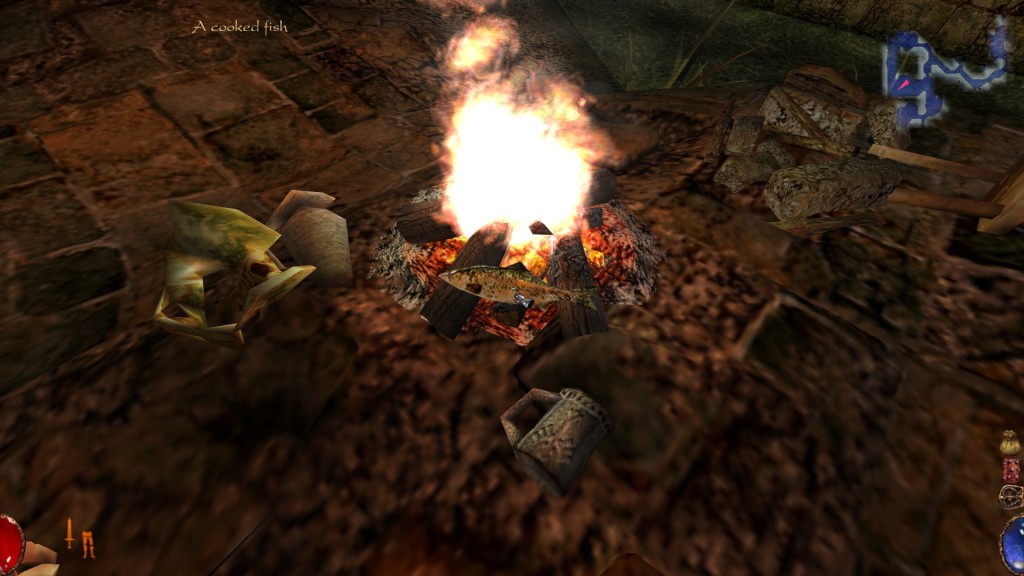
In this section, the player also learns the basic of combat against a few rats, spiders, and goblins. Combat is a fairly simple action affair, but still comes with some nuances. You select an attack (left/right slash, overhead slice, or downward stab) by how you’re moving when you press the attack button, and holding the attack button charges up the damage of the swing. Like Ultima Underworld, I surmised that certain attacks are more intuitively beneficial with certain weapons e.g. bashing is more effective with the club than stabbing, though I didn’t focus on melee combat as much so I likely missed some of the subtleties. The enemies fight with the same rules as the player, so combat becomes a dance where you must avoid enemy hits while returning with charged up swings of your own (sometimes you can hit multiple enemies at once). Since enemies can frequently have the same or better range as the player depending on the weapon each wields, this can sometimes be tricky as there is no method of blocking attacks (shields simply raise armor class). I learned that one effective way to avoid damage was the jump, whose mechanics bothered me at first but which I later appreciated for its utility as a makeshift combat dodge. The jump is a quick hop with an accelerated arc, but the player character is slowed for a moment upon landing. This is balanced and gives the jump its unexpected boon to combat, but it frankly feels bad in a first-person game where you can’t see why your character is stumbling. It also is one of several restrictions on movement which seem to be imposed by the player character’s 3rd person animations (which I confirmed exist when my camera bugged and stayed locked to 3rd person after a conversation when I regained control). The player cannot lean when holding a weapon or when crouched, presumably because there would be no animation for such in those two states. This takes out much of the point of leaning, as it cannot be used to take aim with ranged attacks or when crouching low to stay out of view. Similarly, spells cannot be cast while crouching, exiting crouch has a laborious wait appended to it, and sneaking while holding a weapon appears to do nothing. Arkane’s later games nail snappy flexible movement mechanics with rock-solid game feel, so it’s a shame it feels so clunky here.
Since Arx Fatalis is an RPG, many of the player’s actions are dictated by their choices in character progression. Arx Fatalis features 4 stats (STR/DEX/INT/CON) which govern 9 skills. STR grants access to the more powerful weapons and combat gear and increases melee damage; DEX increases critical chance and decreases the time it takes to fully charge up a strike while improving stealth and technical skills; INT increases the player’s mana pool and improves a number of skills related to magic; CON increases the player’s hit points and raises defense. There are standard skills for close and ranged combat, stealth, spellcasting, and defense, as well as skills that logically bundle granular improvements together with binary skill requirement checks to make them more attractive – the Intuition skill improves the player’s bartering for goods in addition to revealing secrets, the Ethereal Link skill improves the player’s mana regeneration skill in addition to revealing enemy statistics, and the Object Knowledge skill improves the player’s ability to repair their gear and apply poison coating to weapons in addition to identifying and using items. If I extrapolate from my own playthrough, it seems that the best approach is to commit almost entirely to one stat and play as a fighter (STR), rogue (DEX), or mage (INT) and level up the associated skills and CON for extra hitpoints as necessary. I ended up going for the rogue build, opting to strike from the shadows and using spells to evade and set traps for my enemies. Overall, my skill choices only felt impactful midway through the game when I could start to reliably avoid detection and lean into my technical skill with lockpicking and disarming traps. Improvements to STR grant fewer skill increases per level than DEX, but allow the player to brute force many of the game’s challenges with heavy weapons, armor, and sheer power. By contrast, the raw skill increases from INT and growing list of potent magical spells offer a vast toolkit to blow enemies away and subvert the game’s systems to the player’s will, but require a longer investment ramp to reach their full potential. CON seems a bit of a waste, and should be taken to the minimum that the player needs for their comfort level with the combat. Because of these aspects, the player must stick to investing into a few things they want to be good at rather than spreading their points thin by hybridizing. I think this could be softened somewhat by tamping down on the exponential growth of the level curve. I finished the game at level 8 (out of possible 10), with nearly 35,000 XP attained in my final 5 hours of gameplay that amounted to nothing. It’s possible there are some opportunities for grinding (enemies only respawn at key progression points, but I noticed a door that I could infinitely lockpick via tedious level loading for very minor XP gains), but I think I should have been closer to reaching level 10 after doing all of the side content I could find and reaching the endgame areas. In addition, I think some work could be done to make the player feel more pull to stats and skills outside their core build. As an example, I’m of the mind that secrets should remain hidden to a character without a way to reveal them as I personally found it too easy to spot texture seams and discolorations, and believe this would not be overly restrictive as there are spells and even a well-hidden item that can reveal secrets anyway. CON’s description lies when it says it affects equippable armor (this is limited only by STR), and it probably ought to increase the player’s base health regeneration. The Defense skill would be more enticing if it were tied to an actual blocking mechanic of some kind, and I can think of several ways that the Technical skill could be made less RNG-dependent and therefore rewarding of savescumming.
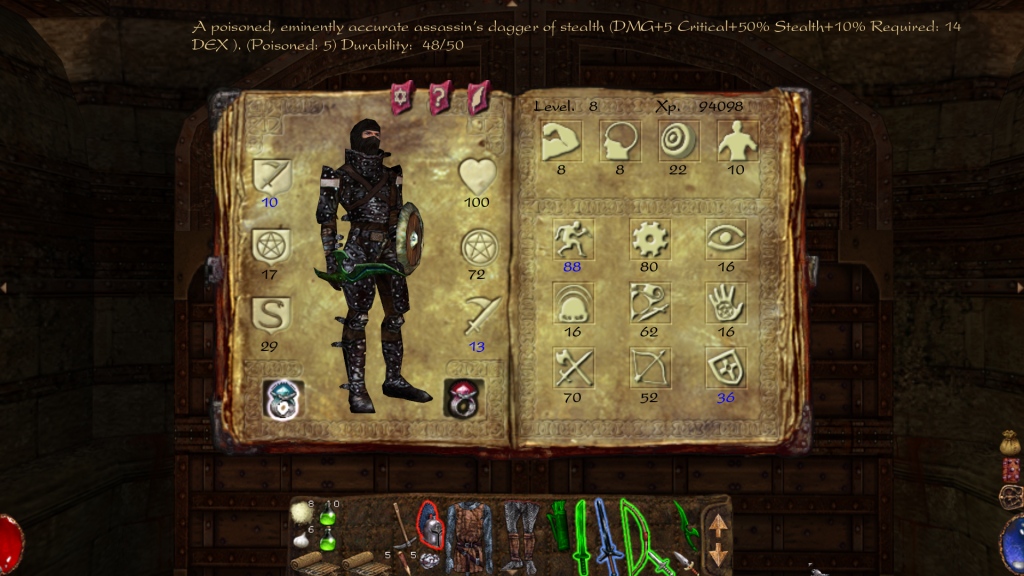
Particularly relevant to my playstyle, Arx features a somewhat basic stealth system where the player can dampen footsteps by walking slowly and stick to the shadows to reduce their visibility, as indicated by a dynamic sneaking icon in the user interface. Both techniques are improved by the stealth skill, which needs to be increased quite a bit before sneaking is truly viable. However, I did find the rogue playstyle surprisingly effective. Many have insisted that the Projectile skill is useless, and I was explicitly dissuaded from even considering using the bow before I booted up the game. However, with a little experimentation I found ranged combat to be highly advantageous provided you know what you’re doing. Somewhat counter-intuitively, arrows do more damage when fired from longer ranges, which along with the bonus critical damage from stealth hits and general benefits to remaining undetected, leads to an interesting puzzle in the confined interior environments where the player has to seek out shadowy hiding spots and appropriate firing angles from which to snipe targets from afar. The level and encounter design affords this to a surprisingly nuanced degree, with many looping corridors and vertical vantage points (try the levitate spell!) allowing for a stealthy approach if the player is clever about their positioning and timing. I managed to clear out the entire final dungeon of 7 of the toughest and most brutal enemies in the game with 50 poison arrows despite only having 50% Projectile skill (due to raw gains from my DEX stat increases) by abusing an invisibility spell between each arrow fired to allow the enemy awareness AI to reset. The same worked for many of the other encounters, allowing me to thin out patrolling groups before cleaning up with my stealthy dagger. Stealth itself can be fun with some investment, alongside invisibility spells and potions to dart between shadowy hiding places. Though it’s not as obvious as in Thief, the player can throw items to divert enemy’s attention and use a spell or even bottles of water on hand to extinguish torches to darken a room. If I have one complaint regarding the rogue DEX build, it’s the extreme lack of diverse stat/skill requirements among weapons. Out of 27 total, there are 17 weapons with STR requirements, 1 dagger with a DEX requirement, and only 2 ranged bows, each with Projectile skill requirements (the latter of which I never found). The game would strongly benefit from some curved swords and rapiers aimed at DEX characters and perhaps some hybrid STR+DEX weapons like spears alongside a much wider suite of ranged weapons such as throwing knives/axes/spears and perhaps crossbows requiring STR to load. These would fill out the gear progression for more distinct character builds, and would also lead to more interesting encounters where enemies with different weapons require different strategies to beat.

A dungeon crawler at its heart, Arx Fatalis’ gameplay is about exploration, loot gathering and resource management, combat, and solving riddles, with each of these tied into one another. Upon reaching each new area, the player must map out their surroundings while dealing with enemies and hazards, collecting useful items, and unlocking roadblocks to progress. Though the combat system is not particularly exciting on its own merits, it can be interesting in concert with the other elements. Enemy patrols and ambushes create tension and make the dungeons feel threatening, as well as adding a layer of tactics and resource management to basic exploration. Enemies can signal allies to their position and surround the player or chase them into a trap, but on the flipside a well-prepared player can run roughshod on an enemy encampment and make mincemeat of their comrades before anyone can react. This all came together for me when I found myself creeping through a makeshift cultist base in an abandoned cavern, avoiding the sentries’ sightlines by jumping and levitating from ledge to ledge and taking note of patrol routes with my night vision spell while perched high above. Even the process of making your way in low-light conditions can be engaging (particularly as I play with gamma one notch above minimum so light is important to gameplay) — torches are somewhat common and can be easily stashed and relit but burn out quickly and make you very visible to enemies, while a night vision spell can keep you well-hidden but slowly drains your mana, and recasting the spell will actually light up your position as you draw the runes. It pays to be prepared, whether that means precasting up to 3 spell slots, keeping your weapons in good condition, coming with enough healing items, or enchanting and poisoning your weapon before a fight. When that fails, however, it’s crucial to be able to think on your feet and come up with a backup plan. For me that often meant casting a quick speed spell to run to safety and switch to a more favorable melee weapon, perhaps preparing an emergency fireball or a paralyzing touch to gain the upper hand. You’ll be fighting rats, spiders (including some giant scary ones), goblins, rat-men assassins, zombies, cultist mages, and a handful of extremely powerful enemy types that I won’t spoil, and some of them can be quite fearsome before you’re properly geared up. The game shines when the player is caught by surprise by a powerful enemy they weren’t ready for, requiring adaptive and creative thinking in the moment to respond. Though dungeon layouts usually afford multiple routes to approach or avoid combat, the player is occasionally locked into a straight fight, which was somewhat challenging for my build but still fairly doable.
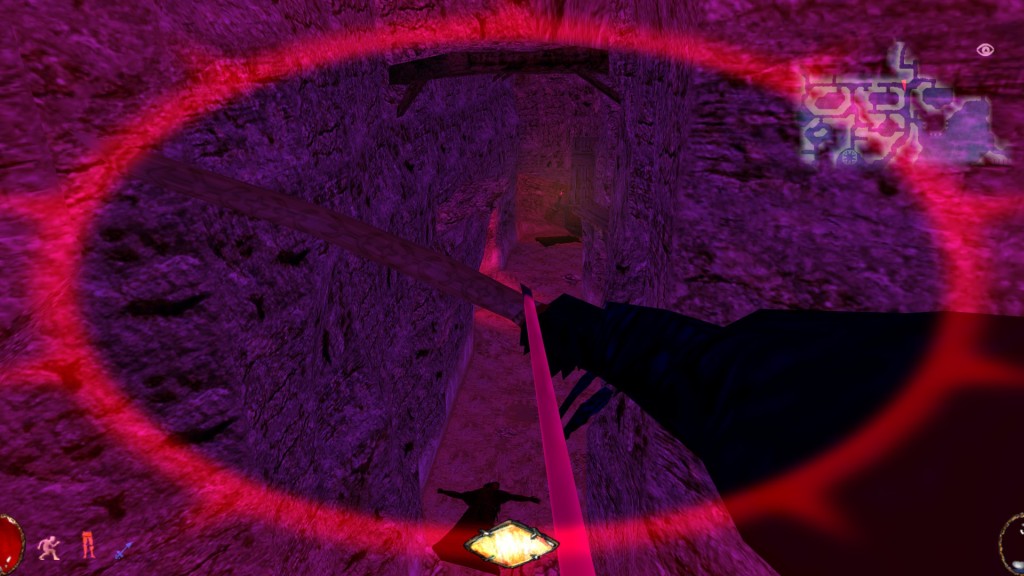
Arx Fatalis takes place in a world where the sun has been snuffed out, forcing its inhabitants (humans, drawves, goblins, trolls, rat men, and more) underground into dense cave networks. The game world is one of these subterranean labyrinths, spanning 8 descending levels from the kingdom of Arx down to molten dwarven mines. This compact design allows the designers to flesh out the world with hand-crafted and richly detailed environments that feature many secret alcoves, interactable props, and scripted events that sell the illusion of a dynamic living world. While the main quest demands a large degree of exploration, there are many places the player will find only as a matter of their own curiosity and bravery. After three increasingly harrowing levels of a crypt that are required to recover an enchanted artifact from a tomb, the player has the option to delve two levels yet further, leading to even more elaborate traps, confounding riddles, and deadly enemy encounters guarding the penultimate reward. I stumbled onto some sections of the world much earlier than the story required, which led to an “Aha!” moment when I eventually realized what I needed from them. As you progress through the story, areas will populate with different creatures and changes will take place. At one point I happened upon a caravan in some caves with whom I traded some items for gold, and when I came back later they had been killed by a pack of marauding goblins and their stash of merchandise dragged to a nearby hideout. I was able to recover my lost gear plus the wares originally on display, though not without a pang of guilt for not having thought to seek out a way to protect them. Though it is not always forthcoming about them, the game does offer some hidden choices in the story. I found a way to get an audience with the goblin king and obtained his permission to search the reserve for an idol that had been stolen from the trolls – causing them to strike from mining gems for the goblins – but I found some clues that suggested there might be an alternative quest solution involving a usurper to the throne, though I never figured out how to trigger it. Many hours later, the troll king opined that he couldn’t sell the gems his workers mined himself because he had no knowledge of finance, which I was able to teach him. ultimately angering the goblins for cutting off their supply of riches. Since there are no dialogue options, all story choices must be conveyed through the player’s actions, be it the presentation of a key item to an NPC, violence against them, or even just withdrawing and seeking alternative means to solve a problem. Like with the cooking system, this lends an consistency and authenticity to the player’s interactions with NPCs, as they are incorporated into the end-to-end experience like all other choices in gameplay.

Previously I stated that a key component of Arx Fatalis is the solution of riddles. While most would likely call these puzzles, I have taken to the term riddle to describe problems presented to the player which don’t rely on a consistent set of rules which the player must experiment with to mentally model and then invert to find the solution, but rather one-off obstacles which require lateral thinking and intuition to solve (for more detail on this distinction, see Blubberquark’s excellent blog post on the subject). While many of these riddles are memorable and engaging, Arx does suffer from inadequate signposting for its more cryptic riddles at times. Some quests made me feel particularly ingenious for working out the solution to a riddle right away, but some had me scratching my head and wandering for an hour only to find that what I had sought had been right under my nose all along. Too often, there’s simply no way to gather more clues to help guide you. These kind of progression riddles have been a staple of similar games before, but rarely have I felt so lost and subsequently embarrassed when I found that I had very nearly picked up a key item but simply glossed over it. I must draw a contrast to Ultima Underworld, in which I was able to frequently infer useful hints from notes and journals I found or the things NPCs said and sometimes even what they didn’t say from context. I even partially translated the Lizardman language (that one’s more of a puzzle, see) before I found an expert who taught me the fundamentals. Similarly, there’s always an audio log to point you in the right direction in System Shock if you’re lost, and the notes and overheard conversations in Thief will always eventually point you on the right track. Arx loves to hide its key quest items just out of plain sight, and with the world as open as it is, it can sometimes feel necessary to trek all over the currently explored area in search of something missed, which can be a pain. Just a bit more detail and clues would help make it a more organic process. As it is, I can’t fault anyone for seeking external help – if you’re truly lost, I recommend this hint walkthrough, which reveals only the bare minimum you need and lets you figure out the rest. I turned to it a handful of times when I was completely stumped, and most of the time I found I had the correct idea about a riddle but had simply applied it incorrectly by a small margin.
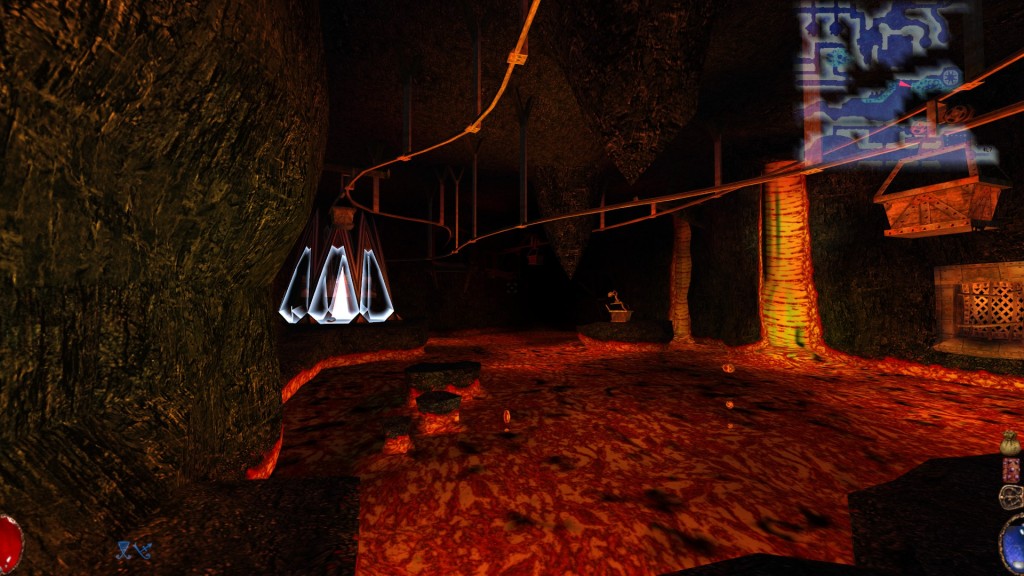
One of the greatest selling points of Arx Fatalis is its rich atmosphere. Its visuals are easily the best among its contemporaries (DX, SS2, TG/T2), sporting precise texture work with excellent lighting that contrasts wonderfully between light and dark. Every zone has its own unique visual landmarks, from the soft greens of underwater lakes to the red magma of the dwarven mines to the cold blue stone of the Order of Edurneum. Each space has had a great deal of thought and care to make it stand out and the environment often has its story to share, from the damage and scorch marks of a battle that occurred just before you arrived to subtle details that demonstrate the function of a given room or give hints as to a homeowner’s personality. In an Immersive Sim, these details can even be important to gameplay, as they offer subtle guideposts for the player to signal where they might find a kitchen to gather ingredients or a smithing anvil to repair their gear, or even to offer clues to a progression riddle. In addition to its pleasant visuals, Arx Fatalis imbues its world with a magnificent and intricate soundscape on par with the Dark Engine games, with ambient sounds of running water, dripping caverns, chirping wildlife, echoing halls, and wind whistling from surface air ducts enveloping the player and smoothly transitioning as they draw near. Every footstep makes a sound that perfectly matches the ground beneath the player’s feet, and the small effects and jingles that play when frying a fish or distilling a potion sell the interactions beyond the abstract dragging and clicking driving them. Enemies have excellent distinct audio work that gives them personality and in some cases makes them very frightening to come up against, particularly the snarl and pitter-pattering footsteps of a rat-men assassin on the hunt for me. Finally, marvelous droning music attaches a unique and instant emotional vibe to each location before the player consciously knows what they’re in for. A warm sonorous melody soaring over a percolating synth made me feel a long-sought respite upon entering the City of Arx for the first time, while a metallic scraping atop a constant seething drone made me feel trepidation the moment I stepped foot in the cultist temple, and a cold and lifeless hum interspersed with smothered feminine laments hinted at something sinister within the walls of the snake women’s Temple of Illusions. The vivid world and engrossing atmosphere of Arx alone make the game worth playing.
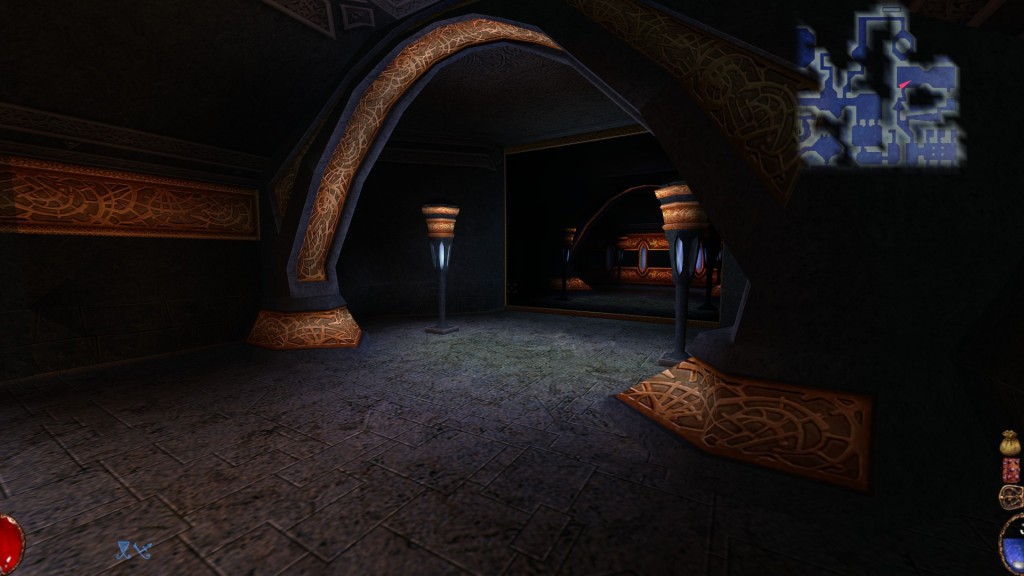
I also rather enjoyed the story and fiction of Arx Fatalis. I won’t spoil too much, but there’s a gradual progression of information as the story unfolds and the player learns of their true purpose in the world, in addition to various dynamics within the factions that be. There are a few twists that take place, but most of the narrative is unfurled slowly as you infer relationships and the meaning of events from context. There are a handful of books scattered around the world which offer further insight into the lore, which is fairly well thought-out and explains life of the denizens of Arx before their sun went out and the course of their dealings since, as well as the cosmic order of the universe and the celestial beings that govern various realms such as Arx. It’s a shame this world has never been developed any further, because it has a certain texture that makes it stand apart a bit from standard fantasy fare. Moreover, there are a few areas where it seems the designers ran out of time – level 7 houses a den of rat-men thieves amidst a network of unsettling fungal structures, but the only story present is that which the player can imagine themselves, despite the hints from the intro and several scripted ambushes that imply they’ll play a larger role. Similarly, level 8 is the realm of the oft-mentioned dwarves, but they have been conveniently wiped out before the player arrives, leaving only a handful of notes that tell of their culture and exploits. The game reaches a conclusion with its primary antagonist that left me satisfied after a well-paced and motivating plot, but I can’t help but wish the developers had a bit more time to flesh it out even further.
Arx Fatalis solidly sits among the finest games I’ve played, up there with the best of the Immersive Sims and standing tall as Arkane’s finest achievement in my eyes. While they would go on to refine their combat, stealth, and movement mechanics to a polished standard and continue to produce games with a similar commitment to immersive simulationist principles with fleshed out worlds and thoughtful level design, the strongly player-driven nature of Arx Fatalis and the world it creates offer a captivating experience that hasn’t been matched. This was Arkane’s passion project, the game they had to share with the world no matter the cost, and that grit and soul paid off. Though Arx Fatalis was not a commercial hit, it ought to be remembered and celebrated, and Arkane deserves the success they’ve had since.
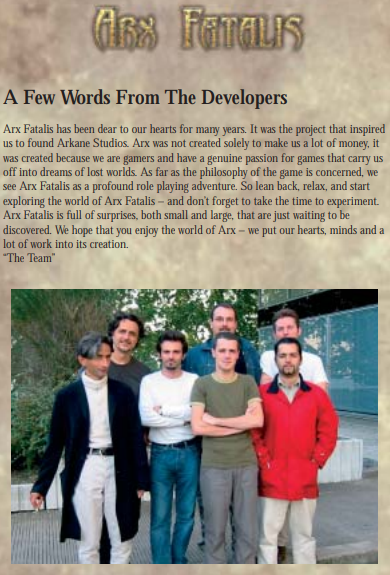
Technical note: I played the game using the Arx Libertatis source port with development build 1.2-dev-2019-07-22, with installation instructions that you can find here. There were some bugs (and a handful of crashes, unfortunately), but it’s overall a smooth experience with a nice set of configuration options, including an improved magic rune detection algorithm. I would definitely recommend the latest build over 1.1, and certainly over the original version to get the best experience.
Who do you simp for, Aakba or the Snake Ladies?
LikeLike
Very down for snake ladies
LikeLike